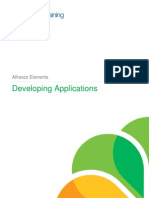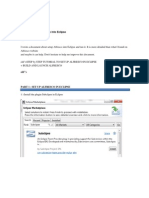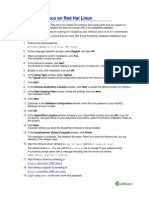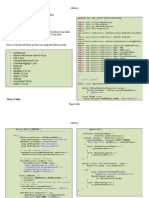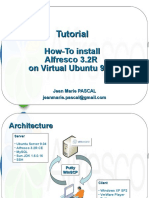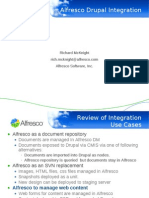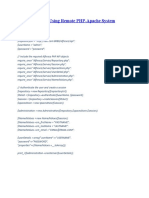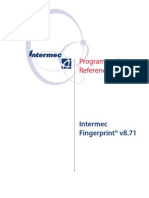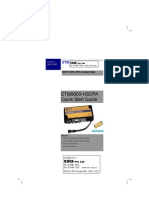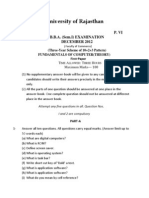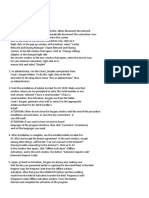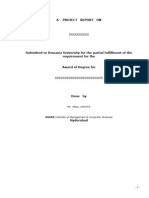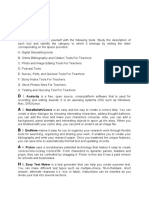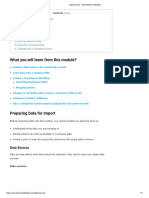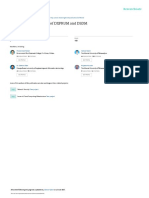Installation and Configuration (Liferay)
Prerequisites
Liferay v5.2.3 installed & working. We have not tested and therefore do not support Liferay 6
at this time.
Admin user knows where Liferay's "deploy" folder is.
If using Tomcat6, the modifications described in our wiki have been
deployed: http://wiki.alfresco.com/wiki/Install_Tomcat6
share.war is the one taken from the DocLIb Portlet branch of 3.3.1E, or is 3.4 Community or
newer.
Repository is v3.3.1E or newer
Single-server Installation Steps
We assume you’ve installed the Alfresco and Liferay Tomcat bundles into separate directories. We’ll
refer to these as<ALFRESCO_HOME> and <LIFERAY_HOME>
Step 1. Configuring Liferay’s Tomcat Server to resolve port conflicts by
editing <LIFERAY_HOME>/<tomcat>/conf/server.xml:
Change all the port numbers to avoid conflicts with the Alfresco’s Tomcat server, here are the
changes I made:
...
<Server port="8105" shutdown="SHUTDOWN">
...
<Connector port="9090" protocol="HTTP/1.1"
connectionTimeout="20000"
redirectPort="9443" URIEncoding="UTF-8" />
...
<Connector port="8109" protocol="AJP/1.3" redirectPort="8443"
URIEncoding="UTF-8" />
...
Step 2. Next, edit <LIFERAY_HOME>/<tomcat>/conf/catalina.properties and locate the
“shared.loader” entry and replace it with this:
shared.loader=${catalina.base}/shared/classes,${catalina.base}/shared/lib/*.jar Step
3. Edit<ALFRESCO_HOME>/tomcat/shared/classes/alfresco-global.properties and add the
following lines to the end of the file:
shared/classes/alfresco/alfresco-global.properties
authentication.chain=alfrescoNtlm1:alfrescoNtlm,external1:external
�external.authentication.proxyUserName=
NOTE: Yes, the value for proxyUserName needs to be blank.
Step 4. Copy <ALFRESCO_HOME>/tomcat/webapps/share.war to <LIFERAY_HOME>/deploy
Step 5. Copy the entire <ALFRESCO_HOME>/tomcat/shared directory
to <LIFERAY_HOME>/<tomcat>/
NOTE: Technically, we only need the shared/classes/alfresco/web-extension/ directory, but
copying the whole shared directory is a convenient alternative.
Step 6. Open <LIFERAY_HOME>/<tomcat>hared/classes/alfresco/web-extension/share-config-
custom.xml.sample toshare-config-custom.xml and edit the file to uncomment the second config
block to enable remote authenticator. The comments are on lines 44 and 73. The result should look
like this:
shared/classes/alfresco/web-extension/share-config-custom.xml
Note: Modify endpoint-url parameters to match actual Repository deployment.
<alfresco-config>
<!-- Overriding endpoints to reference a remote Alfresco server -->
<config evaluator="string-compare" condition="Remote">
<remote>
<endpoint>
<id>alfresco-noauth</id>
<name>Alfresco - unauthenticated access</name>
<description>Access to Alfresco Repository WebScripts that do
not require authentication</description>
<connector-id>alfresco</connector-id>
<endpoint-url>http://localhost:8080/alfresco/s</endpoint-url>
<identity>none</identity>
</endpoint>
<endpoint>
<id>alfresco-feed</id>
<name>Alfresco Feed</name>
<description>Alfresco Feed - supports basic HTTP
authentication</description>
<connector-id>http</connector-id>
<endpoint-url>http://localhost:8080/alfresco/s</endpoint-url>
<basic-auth>true</basic-auth>
<identity>user</identity>
� </endpoint>
<connector>
<id>alfrescoCookie</id>
<name>Alfresco Connector</name>
<description>Connects to an Alfresco instance using cookie-
based authentication</description>
<class>org.springframework.extensions.webscripts.connector.AlfrescoConnecto
r</class>
</connector>
<endpoint>
<id>alfresco</id>
<name>Alfresco - user access</name>
<description>Access to Alfresco Repository WebScripts that
require user authentication</description>
<connector-id>alfrescoCookie</connector-id>
<endpoint-url>http://localhost:8080/alfresco/wcs</endpoint-url>
<identity>user</identity>
<external-auth>true</external-auth>
</endpoint>
</remote>
</config>
</alfresco-config>
NOTE: If you’re running Alfresco’s Tomcat server on a different host or port, please change the
corresponding endpoint.
Step 7. Startup Alfresco, then follow up with starting Liferay.
Step 8. Once Alfresco and Liferay are started, add and try out the basic CMIS Repo Browser portlet.
It should appear under the “Alfresco” category.
This integration makes use of an external authenticator that will automatically create an Alfresco user
account whenever a new Liferay user accesses an Alfresco portlet.
Developing New Portlets
To create your own custom portlet, I recommend you look at the CMIS Repo code under in the
share.war file under WEB-
INF/classes/alfresco/webscripts/org/alfresco/test/cmisrepo.* and cmisfolder.*.
In short, you’ll need to create a Web Script which can be placed inside the share.war file under WEB-
INF/classes/alfresco/webscripts or
�in <LIFERAY_HOME>/<tomcat>/shared/classes/alfresco/web-extension/webscripts(create the
directory if it doesn’t already exist.
You’ll also need to edit the portlet.xml file in the share.war/WEB-INF directory to add a new entry for
your portlet using the Alfresco “ProxyPortlet” as the portlet class.
<portlet>
<description>CMIS Folder Browser</description>
<portlet-name>CMISFolder</portlet-name>
<portlet-
class>org.alfresco.web.portlet.ProxyPortlet</portlet-class>
<init-param>
<name>scriptUrl</name>
<value>/share/service/sample/cmis/repo</value>
</init-param>
<supports>
<mime-type>text/html</mime-type>
<portlet-mode>VIEW</portlet-mode>
</supports>
<portlet-info>
<title>CMIS Folder Browser</title>
<short-title>CMIS Folder</short-title>
</portlet-info>
</portlet>
Finally add your portlet to the liferay-display.xml and liferay-portlet.xml files.
To make sure that your URLs are correctly generated, please use the “scripturl()” function in your
Freemarker templates to wrap them:
<a href="${scripturl(url.serviceContext + "/sample/cmis/repo",
false)}">CMIS Repository</a>















